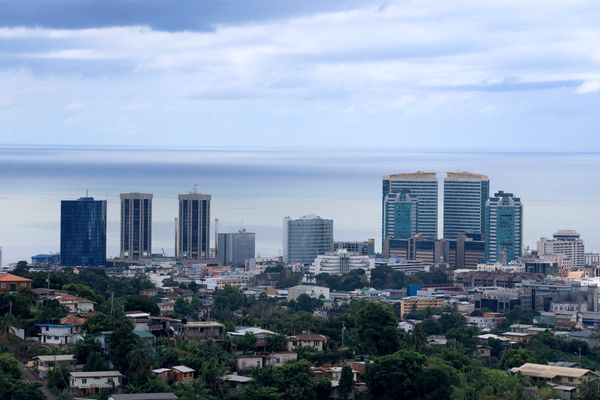
The first home guarantee is expanding from Wednesday, making it easier for prospective homebuyers to take out loans.
All first-time buyers will be eligible for the federal government’s scheme, which waives the lender’s mortgage insurance charged to borrowers with small deposits (though there are caps on loan values).
The scheme is designed to help thousands of people buy a home sooner, but experts say it will keep property prices surging into 2026, with median values tipped to rise up to $85,000 higher than they are today.
Here’s what you need to know about the expanded first home guarantee.
Sign up: AU Breaking News email
Who is eligible for the first home guarantee?
Applications are open to all prospective buyers of an owner-occupier home who have not owned property for at least the past decade and are either Australian citizens or permanent residents.
Aspiring buyers must intend to buy a property within the price caps for their local area, ranging from $1.5m in urban New South Wales and $1m in Canberra and south-east Queensland to $400,000 on the Christmas and Cocos Islands.
From 1 October, the government has raised the scheme’s price caps above most regions’ median property value – which means the majority of homes are eligible.
Limits on applicant numbers and incomes will be scrapped. But those who rent out their property or have already bought their first home are still not eligible.
How can buyers apply for the guarantee?
Buyers who are ready to apply for pre-approval for a loan can get their bank or mortgage broker to help them apply for the government scheme, according to Patrick Johnson, owner of Mortgage Choice, Sutherland Cronulla and Wollongong.
“You do your pre-approval and, whilst you’re submitting that application to the lender, you also submit the [guarantee] paperwork,” he says.
But acceptance for the scheme is not automatic and not all banks offer customers the scheme, with ANZ and Macquarie among the major exceptions.
Borrowers should ensure their deposit money are genuine savings, as some lenders expect deposits to be held for or saved up over six months, Johnson says.
“You couldn’t, say, get a [cash] gift from mum and dad [or] win on the pokies and use that the next day,” he says.
Once buyers are approved for the guarantee, they have 90 days to find a home and sign a contract of sale, according to Housing Australia, which administers the scheme. They must then continue to live in the property as an owner-occupier to remain covered by the guarantee.
How does the guarantee cut costs?
The guarantee will see the government waive the additional fees often charged to small-deposit borrowers when they take out their loan, called lender’s mortgage insurance (LMI).
Without the scheme, banks would typically require borrowers who put down deposits of less than 20% of their loan to pay LMI. The LMI insures the bank against losses if the customer fails to repay their loan.
LMI costs vary depending on the borrower and the loan size but can be tens of thousands of dollars, forcing buyers to either pay the charge upfront or go into more debt, Johnson says.
With the scheme, successful applicants will not have to pay LMI. The government will guarantee the loan instead, erasing the cost to homebuyers.
The guarantee could also indirectly increase the amount participants can borrow. Banks typically charge higher interest rates to customers with small deposits but some lenders will offer scheme participants lower rates, according to Graham Cooke, head of consumer research at Finder.
“It is not guaranteed across all lenders [so] shop around and play the lenders off against each other to get the best deal,” Cooke says.
Renters who have sufficient incomes to use the scheme would probably save money by buying into the housing market sooner and trading rent price hikes for mortgage repayments, property analytics firm Cotality has found.
Prospective buyers will still have to pay stamp duty, application fees and legal costs. Buyers should still consider putting down a 20% deposit if they have sufficient savings, as that would reduce their debt and therefore their repayments, Johnson says.
Will the guarantee boost home ownership?
The guarantee will cut deposit requirements by three-quarters, reducing the savings wait time for people earning incomes high enough to pay off a home loan.
Borrowers in Melbourne, Brisbane and Adelaide who would typically have had to save for more than eight years could now wait just two, analysis by real estate platform Domain indicates.
About 110,000 people buy a home for the first time each year, about 50,000 of whom access the existing income-capped guarantee. The government expects about 30,000 more people will access the expanded scheme.
Lateral Economics has estimated ownership rates may only rise marginally, from 66% to 67%, as many guarantee users would have bought a home anyway, by paying LMI or seeking family support.
People on low incomes that cannot already afford to service a home loan will not see their borrowing power increased and could be worse off if the guarantee boosts house prices, according to that research, commissioned by the Insurance Council of Australia.
Will the guarantee boost house prices?
Treasury has advised the government the scheme will push up home prices by 0.5% over six years but some experts believe the true impact will be greater.
Three interest rate cuts have already driven up home prices in Australia nearly 5% over 2025 so far, with the national median rising from $815,000 to about $855,000. It’s set to rise another $10,000 by the end of the year, according to big banks’ forecasts of 6% price growth.
While predictions for 2026 growth are mixed, Westpac has forecast surging demand will see prices rise by an extra 9%, which would push the median national home price above $940,000 by the end of next year, $85,000 higher than it is today.
The guarantee’s expansion will likely make price growth and auction competition even more intense for cheaper entry-level homes, according to Eliza Owen, head of research at Cotality.
“There will almost certainly be a short-term boost to home values up to the threshold of the scheme, coinciding with interest rate falls and tight levels of housing supply,” Owen says.
Will you be accessing the expanded first home guarantee? Tell us about your experience by emailing us at australia@theguardian.com







